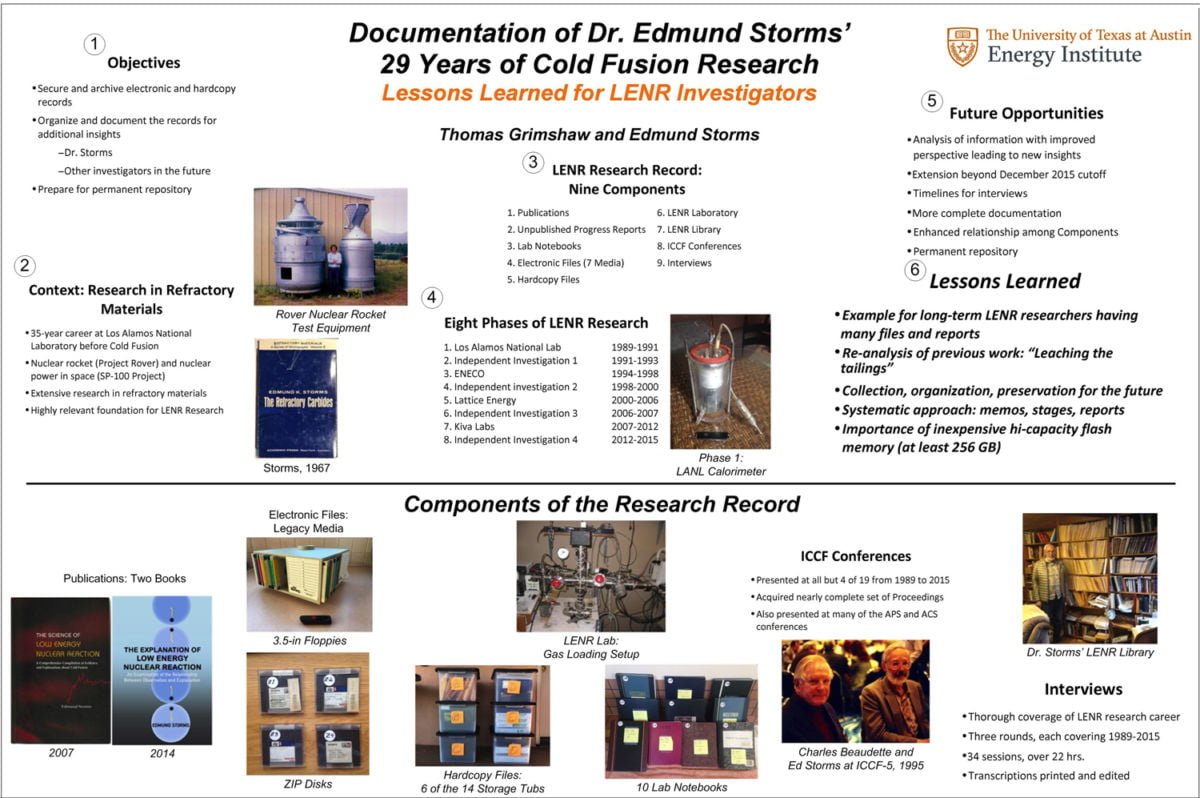29 Years of Cold Fusion Research
ICCF-21 Poster 9 180530

Documentation of Dr. Edmund Storms’ 29 Years of CF Research: Lessons Learned for Long-Term LENR Researchers by Thomas Grimshaw University of Texas at Austin and Edmund Storms Kiva Labs
[.pdf]
Excerpt:
Dr. Edmund Storms was one of the first researchers to follow up on the cold fusion claims of Martin Fleischmann and Stanley Pons in March 1989. He has continued his cold fusion (now widely referred to as low-energy nuclear reactions, LENR) research in the years since, first in his position at Los Alamos National Laboratory (LANL) and then in his home laboratory in Santa Fe, New Mexico. His work has included both laboratory experiments and development of explanations of the LENR phenomenon.
During his 29 years of investigations, he has developed one of the most extensive LENR research records in existence. Much of this work is available in the public realm through his publication of papers and presentations at conferences. There is in addition an extensive body of research results that are in his private files. A project, termed the “Storms LENR Research Documentation Project”, has been undertaken to compile the publicly available documents and to capture, organize, store, and document the private records.
Dr. Storms had enjoyed a 35-year career at LANL, primarily in advanced materials research, when LENR was announced. His pre-LENR investigations were mostly in refractory materials, such as the carbides and nitrides, for hightemperature nuclear energy applications (nuclear rocket, nuclear power source for space). This highly relevant foundation enabled him to quickly become established as a premier investigator in the LENR field. He has conducted many types of LENR experiments, utilizing most of the methods for achieving the effect, including the Fleishman-Pons approach (electrolytic cells) and the gas discharge and gas loading methods. He has also designed and constructed many kinds of calorimeters for measuring excess heat.
As a consequence of his many years of LENR research, Dr. Storms has developed a large body of experimental data along with many publications and unpublished reports. The records collected for the Project have been organized into Components based primarily on the source of information: publications, unpublished progress reports, work history (lab notebook entries), electronic files, hard-copy materials, LENR library holdings, interviews of Dr. Storms, and ICCF conferences.
The principal objectives of the LENR Research Documentation Project are to secure and archive the public and private collection of hard-copy and electronic LENR files and to make the materials more accessible for Dr. Storms and others who are interested in the LENR field to conduct more enhanced review for additional insights. The Project scope is from March 1989 through December 2015. It began in August 2015, when Dr. Grimshaw made his first onsite visit. Eleven more trips were made to collect information, interview Dr. Storms, and prepare documents.
An incremental approach was used to collect information because the full scope of the research materials was not known in advance. The first steps were to prepare memos describing each element as it was found. More than 80 memos were prepared. The Project was conducted in three stages. Reports were prepared for each stage. The Stage 1 report documented the information obtained. The Stage 2 objective was to organize the Stage 1 information. The organization was accomplished by developing timelines for each Component. The Stage 3 (Final) report includes appendices with timelines for each Component. Annexes with the publications and progress reports, Dr. Storms’ interviews, and copies of the memos prepared for the Project were also included.
There are a number of opportunities for additional development and analysis of Dr. Storms’ LENR research record. Almost all of the Project Components could be documented in greater detail, and the associated timelines could be further refined, leading to a more complete Integrated Timeline. In particular, the relationship among the Components could be further analyzed and a more complete picture developed for the research and results. Since the cutoff date for the Project is December 31, 2015, the effort could also be extended for 2016 to 2018.
Technical analysis and interpretation could be another fruitful area for further development. Dr. Storms is currently conducting additional review and analysis for new insights or discoveries. A permanent location for the hard-copy and electronic records will be advisable, such as a repository at a qualified and interested university.
Documentation of Dr. Edmund Storms’ 29 Years of CF Research: Lessons Learned for Long-Term LENR Researchers by Thomas Grimshaw University of Texas at Austin and Edmund Storms Kiva Labs
[.pdf]
